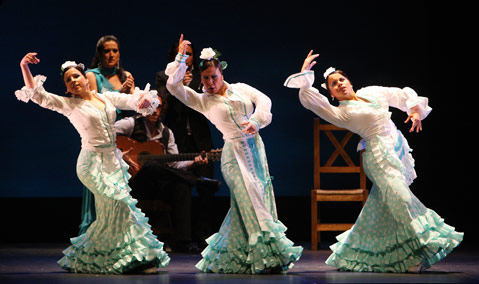The Lobero Hosts 12th Flamenco Arts Festival
Spanish Duo Andrés Peña and Pilar Ogalla Take to the Stage on September 29

Santa Barbara’s ties to Spain date to the 16th century, when explorer Juan Cabrillo first sailed through the Channel. Evidence of the region’s Spanish colonial history lives on in our architecture, our street names, and our civic celebrations. Yet it wasn’t until the year 2000 that Santa Barbara became home to an internationally recognized celebration of Spanish culture: the Flamenco Arts Festival. Now in its 12th season, the festival presents Andrés Peña and Pilar Ogalla in Cádiz de la Frontera this Saturday, September 29, at the Lobero Theatre.
In past years, father/daughter organizers Albert and Vibiana Pizano have brought to town such luminaries as Javier Barón, Cristina Hoyos, and Eva Yerbabuena. What excites the Pizanos most about Peña and Ogalla is their unusual story — they’re a married couple as well as artistic partners, and Cádiz de la Frontera tells the story of their creative union. What follows is an interview with the artists, who answered my questions via email; Albert Pizano translated their responses.
How did you two meet? We have known each other ever since our work brought us together. Our friendship became more serious when we started to work at Los Gallos, a tablao [flamenco club] in Seville where we saw each other every day. In those days, everything was magical.
The title of your show is a blend of two Spanish city names: Cádiz and Jerez de la Frontera. Can you describe the different flamenco traditions of these regions, and how you bring them together in this show?
Peña: I am spiritually tied to my homeland. Jerez is in the interior of Spain, and its people are dedicated to working the land. Here, flamenco developed despite the fatigue of working its vineyards and fields in order to be self-sufficient. It is a flamenco that was developed in isolation. We have a unique, fast rhythm in Jerez, the bulería, which was developed as a means of diversion from work. The name bulería comes from the word burla, which means humor, or to laugh — the town needed something to forget its hard working days.
Ogalla: In my case, it is all different. Cádiz is a seaport. It is influenced by other ports, and there is a heavy interchange with Latin America. Its songs are the results of this interchange: tanguillos, guajiras, milonga, and alegrías de Cádiz. Compared to the flamenco of Jerez, our rhythms are happier, perhaps because of the sun, the shoreline, and the freedom of the fishermen.
This production emerged because after being together for five years, we realized that our relationship had satisfied our artistic and cultural thirst. It was an enrichment of our lives in every sense. We felt we should share this joy with our public. Love crosses borders, and we decided to blend the traditions of Cádiz and Jerez by creating Cádiz de la Frontera.
What are challenges and the benefits of having your spouse as your creative partner? In order to grow, you have to change. You must let new and different sensations enter your life. When you do this, you feel more responsible at times; other times you feel crazy and bold. It is a marvelous sensation, and we want to invite the rest of the world to share it with us.
What is the greatest joy of dancing flamenco? It is very gratifying when the public, from its theater seats, becomes part of our world. We practice a traditional flamenco that hopefully the whole world will understand from the first moment they encounter it. We feel that dance has to reach the soul from the first moment — perhaps because the world is so large that we will never travel the same road again.
Flamenco artists often talk about duende, a word that is hard to translate into English. What does duende mean to you?
Peña: It is a magical state that is produced spontaneously when the various components of a production work in unison.
Ogalla: It is when one ceases to look and listen, and instead sees and hears.
4•1•1
The Flamenco Arts Festival presents Andrés Peña and Pilar Ogalla in Cádiz de la Frontera at the Lobero Theatre (33 E. Canon Perdido St.) on Saturday, September 29, at 8 p.m. Call (805) 963-0761 or visit lobero.com for tickets and info. The artists will teach a series of flamenco master classes at the Boys & Girls Club of Santa Barbara on Sunday, September 30. Call (805) 967-4164 or visit flamencoarts.org for info.



